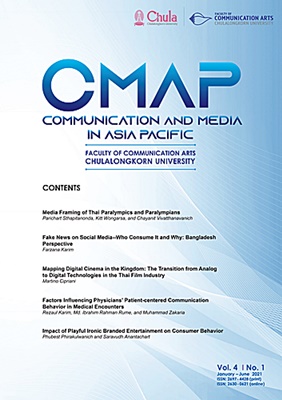Fake News on Social Media--Who Consume It and Why: Bangladesh Perspective
Main Article Content
Abstract
Today, ‘fake news’ is much more than a label for false and misleading information disguised and disseminated as news. It has become a weaponized term used to undermine and discredit journalism. Recently, social networks especially Facebook has become more popular and more comfortable platform for spreading fake news in Bangladesh. According to BTRC's report of November 2017, there are 30 million Facebook users in Bangladesh. So, Facebook has become an easy tool to spread any information with extreme good or bad opinions within a short time. Now a click is both an opportunity and a threat. Fueled by ICT, in recent years, fake news has become a significant concern in Bangladesh. This study aimed to explore the weaponization of information on an unprecedented scale and the power of new technologies provided for the manipulation and fabrication of content peddled by Facebook users. The acts of harassment peddled by fake news spread on Facebook have been increased exponentially from 2012. And by the year 2017, Bangladesh has experienced and combated the bad situation fueled by fake news posts on Facebook. The incidents which took place during these years have drawn the attention to continue this study to find out the consumers of fake news and determine its impact on our mainstream media. Furthermore, this study attempted to identify whether the audience depends on the mainstream media to collect authentic information after the dispersion of fake news. This study used a mixed-method, both quantitative and qualitative approaches, for conducting the research. The quantitative approach was designed with a cross-sectional survey among Facebook users and content analysis. Besides, case study under the qualitative approach provided more profound elucidation.
Article Details
References
Alam, M. H. (2018, July 16). Is fake news rising in our media? The Financial Express, Dhaka. Retrieved from https://thefinancialexpress.com.bd/views/is-fake-news-rising-in-our-media-1531728516
Albright, D. (2017). North Korea’s nuclear capabilities: A fresh look. Institute for Science and International Security Report, 28.
Bangladesh Telecommunication Regulatory Commission, BTRC (2018). Annual Report 2017-2018. Dhaka: BTRC. Retrieved from http://www.btrc.gov.bd/sites/default/files/paper_files/Annual%20Report%202016-2017%20%28English%29.pdf
Bratich, J. (2008). Conspiracy panics: Political rationality and popular culture. Albany, NY: State University of New York.
Caytas, J. D. (2013). Karl Popper and conspiracy theories in Polish political thought. Anthropology of East Europe Review, 31(1), 55-74.
Fuchs, C. (2019). Nationalism on the Internet: Critical theory and ideology in the age of social media and fake news. London, UK: Routledge.
Ireton, C., & Posetti, J. (2018). Journalism, fake news & disinformation: Handbook for journalism education and training. Paris, France: UNESCO.
Klaehn, J., Broudy, D., & Pedro-Carañana, J. (Eds.). (2018). The propaganda model today: Filtering perception and awareness. Westminster, UK: University of Westminster Press.
Naher, J., & Minar, M. R. (2018). Impact of social media posts in real life violence: A case study in Bangladesh. arXiv preprint arXiv:1812.08660.
Ovi, I. H. (2018, December 20). Facebook removes pages spreading fake news in Bangladesh. Dhaka Tribune, Dhaka. Retrieved from https://www.dhakatribune.com/bangladesh/election/2018/12/20/facebook-shuts-down-nine-pages-six-accounts-in-bangladesh
Sunstein, C. R. (2014). Conspiracy theories and other dangerous ideas. Simon and Schuster.
Talwar, S., Dhir, A., Kaur, P., Zafar, N., & Alrasheedy, M. (2019). Why do people share fake news? Associations between the dark side of social media use and fake news sharing behavior. Journal of Retailing and Consumer Services, 51, 72-82.
Talwar, S., Dhir, A., Singh, D., Virk, G. S., & Salo, J. (2020). Sharing of fake news on social media: Application of the honeycomb framework and the third-person effect hypothesis. Journal of Retailing and Consumer Services, 57, 102197.
Verstraete, M., Bambauer, D. E., & Bambauer, J. R. (2017). Identifying and countering fake news. Arizona Legal Studies Discussion Paper, (17-15).
Vosoughi, S., Roy, D., & Aral, S. (2018). The spread of true and false news online. Science, 359(6380), 1146-1151.
Wibowo, K. A., Rahmawan, D., & Maryani, E. (2018). In Indonesia, young and old share fake news on social media. Asian Network for Public Opinion Research (ANPOR) annual conference in November 2018, Retrieved from: https://theconversation.com/in-indonesia-young-and-old-share-fake-news-on-social-media-111433


